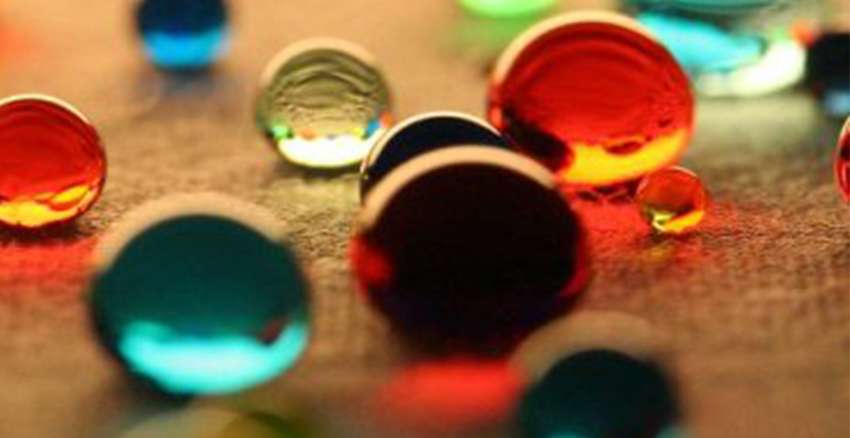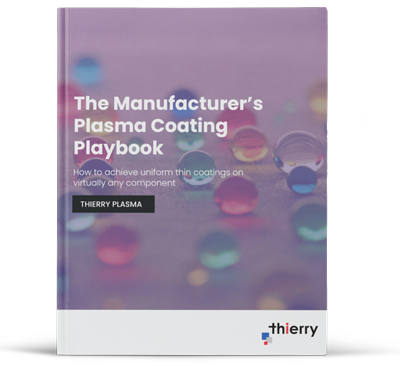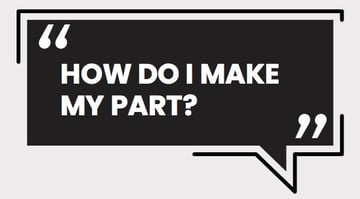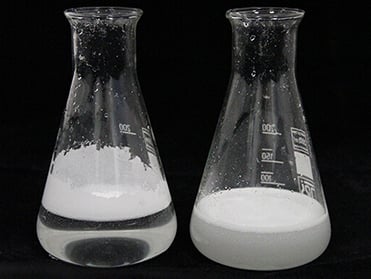
Plasma technology has evolved over the years to include a number of systems and processes designed to modify surfaces for a variety of reasons including to create coatings that repel or attract water, resist scratching, reduce friction, and create impermeable barriers, to name a few.
Plasma coating is a process that uses plasma to activate the surface of a part during manufacturing, creating chemical bonds between different atoms and depositing the resulting short-string molecules to produce a polymer or glass-like coating. This process produces remarkably thin and uniform coatings on parts, optimizing or changing the surface properties of the base material to produce or enhance desirable characteristics such as the above-mentioned scratch and wear resistance, low friction, and hydrophobic or hydrophilic properties.

This eBook will discuss plasma coating technology and how to achieve the optimal thin coating on virtually any component and surface using an environmentally-friendly process that needs no solvents and produces no aqueous toxic waste.

Determining a suitable surface treatment for any given material and part can be a daunting challenge simply because of the sheer number of materials, treatments, and coatings available. In fact, there are between 40-80,000 materials used in materials technology and approximately 1000 surface modification technologies!
In general, there are several fundamental methods of surface modification used in manufacturing, including:
Unlike some other surface modification processes, coating involves covering the surface of a workpiece with a well-bonded layer of material. The quality of the coating is determined in large part by the bond strength which is controlled by:
A strong atomic bond in the contact zone is preferred, provided that internal stresses within the coating are not too high and no long-term degradation occurs within the coating/substrate composite. Coating process and material combinations determine whether mechanical, chemical, or electrostatic bonds prevail, or whether diffusion occurs.
With a plasma treatment it is possible to achieve an optimal adhesion between two materials at the whole interface. The adhesion is provided by forming chemical covalent bonds at temperatures below 50 °C. Plasma treatments create either reactive coatings on the surface or chemically functional groups and radicals in the surface. This enables, for example, metals to be connected chemically with plastics as well as plastics with plastics.

Of course, there are any number of ways beside plasma treatments to achieve acceptable bonding between a coating and substrate. For example, you could choose compatible materials with complementary characteristics that support good bonding, but that may compromise other properties such as strength or durability and may unacceptably increase costs because of the price of the materials required.
Some coatings can be applied successfully in bulk by painting or by using an immersion dip process. However, these processes often need expensive aqueous dip lines that produce toxic waste streams and require additional expense and labor while producing.
Other coating processes use electrostatic methods which apply a charge to the liquid material in a bath and another charge is applied to the parts. This causes the coating material to migrate from the liquid and adhere to the parts. This application is often used to metallize pieces.
The challenge with all of these methods is the quality of the coating, which can be inconsistent and not long-lasting; the application cost is typically higher than plasma coating.
Other process shortcomings include:
Plasma spray coating and low-pressure plasma coating are two common plasma technologies popular for manufacturing. While both are good choices for a variety of applications, there are some processes for which each are particularly well-suited.
Plasma spray coating is a thermal spray coating process that combines high temperatures and a high energy source with an inert spray medium and high particle velocity. It is commonly used to spray ceramics or metals onto parts which need to be hard-faced, heat resistant, or chemical resistant. The process starts by injecting material in powder-form into an exceedingly hot plasma flame. The material is rapidly heated, accelerated to a very high velocity, and sprayed onto a solid material or substrate to produce the desired coating.
This method uses atmospheric plasma sources to produce plasma in an oscillator with a stream or jet of gas in a plasma state that is sprayed over a part or surface to be treated. A sprayed plasma jet does not provide uniform plasma density in the treatment cross-section over an area. This treatment cross-section is also difficult to characterize because an atmospheric plasma source is moved over an area. And because this is a thermal process requiring high temperatures, it can result in carbide
decomposition or excessive oxidation when spraying in air, producing carbide coatings with lower hardness or metallic coatings with higher oxide levels.
Low pressure plasma coating is the process of generating a coating or film on the surface of a part using a mixture of gas or a vaporized liquid monomer as feed stocks in a plasma process that has the advantage of being performed in the same chamber as a surface cleaning and activation process without breaking vacuum. It also has the advantage of being performed as a dry process without the generation of an aqueous waste stream, reducing the exposure of workers to health risks.
This process is often called plasma deposition because the desired coating is produced by depositing the feedstock onto the surface with the introduction of a gas or monomer vapor into the plasma stream. Most plasma vacuum systems are computer-controlled because the process requires precise time and pressure control inside the vacuum chamber to produce the specific required coating thickness and uniformity. This low-pressure application process can be used to produce dense, high-quality coatings in the 10 nanometer- to 100-micron thickness range with lamellar or columnar microstructures.
Deposition may be in the form of:
Low pressure plasma coating offers the following advantages over conventional spray coating:
Once the desired coating thickness is achieved, the process gas is shut off and the chamber purged for good industrial hygiene then vented to enable removal of the parts.
Plasma spray coating is preferred by some manufacturers whose production includes continuous processing because this atmospheric treatment is convenient, similar to spray painting. But because it is a spray, it is not well-suited for coating complex components with a number of dimensional surfaces.
Vacuum plasma technology, on the other hand, can both clean and coat complex shaped parts easily – and because the plasma is diffused it can effectively coat any exposed surface. Comparing the two plasma technologies is similar to comparing a pressure washer with an ultrasonic cleaner: the former is better for continuously cleaning relatively simple parts, the latter is a batch process but much more efficient at getting into the difficult spaces.
There are many advantages associated with using a low-pressure plasma system to activate coatings such as Polydimethylsiloxane (PDMS) compared to using an atmospheric plasma system. The control and uniformity that a low-pressure plasma system offers are far superior to that of atmospheric plasma. Low-pressure plasma activation surface energy of microfluidic device components is better-suited to producing and optimizing covalent bonding in finished devices. In fact, low-pressure plasma activation systems are currently standard for bonding PDMS to any silicon-containing substrate.
Low pressure plasma systems consist of a vacuum chamber, electrodes, a pump, a generator and chemical supplies. State-of-the-art equipment design such as Thierry systems makes it possible to consistently and uniformly deposit high-end nanocoatings on virtually any surface or substrate.
Low-pressure vacuum plasma coating technology provides a number of key manufacturing and economic advantages, including:
Plasma coating or plasma enhanced chemical vapor deposition (PECVD) is an application using plasma in order to modify the properties of materials to produce a coating on a surface. Ultra-thin layers of different molecular groups or monomers are applied on objects and surfaces. With the help of this plasma coating process, surfaces can be made hydrophobic or hydrophilic, scratch resistant, corrosion protected or functionalized to enable bonding.
A vacuum chamber is required with the ability to generate a plasma and inject a coating feedstock to coat the part based on the requirements of its use. A polymerizing gas, monomer vapor, or other coating compounds are added to plasma to produce a coating source in the chamber. This process is then performed over a specified period of time and according to coating parameters to optimize the coating thickness.
The first step in the plasma treatment process is surface preparation. A plasma cleaning and surface activation process is performed to prepare the surface and completely remove any impurities which helps bond the coating to the surface and enhances uniformity.
The next step is the addition of the coating feedstock to the plasma in the vacuum chamber. After the specified time and coating application, the chamber is purged to ensure process gasses are removed, the chamber is vented, and the treated parts removed.

Low pressure vacuum plasma coating is a versatile, flexible way to improve product
characteristics and enhance functionality. Here are the answers to some popular
questions about using low pressure plasma coating.
Hydrophobic - Permanent hydrophobic surfaces are rapidly finding new applications
in a variety of industries. Liquid repellent coatings currently enhance products in the
textile, medical device, ophthalmic and consumer electronics industries, to name but
a few. Polytetrafluoroethylene (PTFE) is a highly popular hydrophobic coating used to
produce a permanent, low surface energy layer on the material or part being treated.
Hydrophilic - A precursor gas is introduced into the chamber where the combination
of energy and low-pressure causes the gas to ionize and become plasma. Polyacrylic
acid or vinyl acetate acid are both good choices for coating. The excited plasma
ions collide with the surface, microscopically changing the geometry of the surface.
Specifically, during a hydrophilic treatment, the surface undergoes oxidation and the
bombarding plasma ions form hydroxyl groups on the surface. These hydroxyl groups
are polar, and since water is polar, it is attracted to them.
Scratch-resistant - Hexamethyldisiloxane (HMDSO) produces a polymer-like or SiO2-
like coating similar to a hard glass. HMDSO is deposited and then oxygen is used to
remove the carboxyl groups and leave a scratch-resistant SiO2 film behind on the part.

Reduce surface friction: The components to be coated can be batched and should be first plasma cleaned and activated to ensure the coating has a clean, active surface to which to bond. Then the batch of parts is exposed to plasma with coatings chosen from a range of PTFE-like materials, SiO2-like materials, or carbon or enhanced carbon coatings.
Apply a carbon coating: Parts are first plasma cleaned and activated for maximum
adhesion. Carbon-containing feed gas is introduced to the plasma chamber resulting
in the deposition of carbon to the surface of the part. This process can be done in tray
fashion or bulk tumbling of parts.
Deposit PTFE structures to a surface: Fluorine-containing feed stock is introduced into
the plasma chamber after thorough cleaning and surface activation. During PTFE coating, pulsing the power is critical to produce PTFE-like coatings. Too much power in the chamber can damage or dissociate the coating feedstock resulting in poor coating quality.
Add a bactericidal coating: Metal compounds such as Ag (and salts) or Cu (and salts) are well-known for their intrinsic antimicrobial property and the release of metal ions is believed to be the main reason for their antibacterial activity. The principle behind the control of Ag ions release is the use of two layer coatings where first antibacterial nano-composite layer is covered by 5-50 nm thick second layer in order to tune coating performance to desirable efficiency and to prolong antibacterial effect of the material. The process is the same as any other plasma coating. The part surface is first cleaned and activated to provide optimal bonding then the monomer-producing bactericidal coating is introduced into the plasma.
Advances in low-pressure plasma coating have opened a new world of manufacturing opportunities. Plasma treatment now enables producers to not just modify and improve the performance of raw materials, but to even invent new ones.
For example, plasma powder activation can improve integration of a specific powder into a compound in which it previously was unable to uniformly disperse. By activating the powder with plasma it can be evenly dispersed within a fluid or polymer, such as rubber. The addition of powder to the liquid or polymer can shift the material properties to produce or improve valuable characteristics such as wear, friction, thermal stability, chemical resistivity, scratch resistance, UV resistance, firmness, and
others.
Plasma’s ability clean and activate powder enables manufacturers to create new materials with new and different properties for their applications. The equipment to plasma-activate and clean powders is highly effective and can be processed in vacuum chambers with volume ranging from as small as 2 liters to as large as 3600 liters, enabling producers to manufacture modified powders in whatever industrial volume they require.

Low-pressure plasma coating can make the difference between an average product and an optimal one. Plasma technology opens doors for producers looking to add value and performance to their raw materials and final products.
Vacuum coating doesn’t just “paint” a part – it actually integrates the coating into the part surface for a far more durable, high-quality finish that can enhance or add performance characteristics to the part or product.
And unlike atmospheric plasma spray coating, low-pressure vacuum-deposited plasma coatings are more uniform, easier to reproduce, safer, and enable the application of virtually any feed stock to implement any surface characteristic needed by the manufacturer.
However, to take full advantage of this plasma technology, it’s important to find a plasma coating provider with computer-controlled vacuum systems to obtain the most uniform and repeatable coatings. The provider should also have broad experience in applying the types of coatings you need for your manufacturing process to ensure the system for your specific applications is properly configured and installed in the production line.

If you’d like to learn more about low-pressure plasma coating technology and discuss either third-party coating service or look into purchasing your own system, contact the plasma coating specialists here at Thierry Corp. We’d be happy to discuss your needs and provide a plasma coating test study.
If you would like to learn more about our company, then please download Thierry's Surface Modification Solution for Manufacturers.
Plasma: +1 (248) 761 9253
Distribution: +1 (248) 549 8600
Fax: +1 (248) 549 3533
info@thierry-corp.com